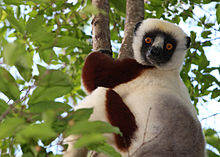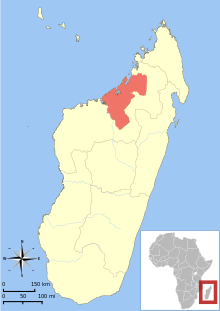Coquerel's sifaka
| Coquerel's sifaka | |
|---|---|
 |
|
| Scientific classification | |
| Kingdom: | Animalia |
| Phylum: | Chordata |
| Class: | Mammalia |
| Order: | Primates |
| Suborder: | Strepsirrhini |
| Family: | Indriidae |
| Genus: | Propithecus |
| Species: | P. coquereli |
| Binomial name | |
|
Propithecus coquereli A. Grandidier, 1867 |
|
 |
|
| Distribution of P. coquereli | |
| Synonyms | |
|
|
The Coquerel's sifaka (Propithecus coquereli) is a diurnal, medium-sized lemur of the sifaka genus Propithecus. It is native to Madagascar. The Coquerel's sifaka was once considered to be a subspecies of the Verreaux's sifaka, but was eventually granted full species level.
Coquerel's sifaka is a vertical clinger and leaper with long, powerful hind legs and an upright posture. It has a head-body length of 42–50 cm and a tail length of 50–60 cm. The total mature length (including tail) is approximately 93 to 110 cm. Adult body mass is typically around 4 kg.
The dorsal pelage and tail are white, with maroon patches on the chest and portions of the limbs. The coat is generally dense. Its face is bare and black except for a distinctive patch of white fur along the bridge of the nose. Its naked ears are also black, and its eyes are yellow or orange. The bottom of the lemurs hands and feet are black, while the thighs, arms, and chest are a chocolate brown. Like all lemurs, Coquerel’s Sifaka’s have a toothcomb. They use it for grooming and sometimes scraping fruit off a pit.
This species occurs at altitudes of less than 300 ft in the dry deciduous forests of northwestern Madagascar, including coastal forests. It occurs from the Betsiboka River, up to the Maevarano River, and are common in large area between these rivers. A recent study reported its southeast-most presence in Ambalanjanakomby along the Betsiboka River. A extensive survey of the species distribution conducted in 2009, 2010 and 2011 led to the confirmation of its presence in most forest fragments between the two above-mentioned rivers. Nevertheless, its eastern distribution limits are unclear, between the Sofia and Bemarivo rivers, the species has twice been reported to be absent (Table 1). Similarly, the southern part of the inter-river system between the Bemarivo and Betsiboka rivers, where little is known about the presence of the species, requires surveys.
Groups of this species have a home range area amounting to 4-9 hectares. A 2014 line transect distance sampling work in Ankarafantsika National Park suggests that population densities ranges from 5 to 100 ind/km²) and significant (negative) effects of road, and forest edge, and/or a (positive) effect of river proximity on densities. The population size may be ~47,000 individuals in the Ankarafantsika National Park. However, the species is frequently seen around villages and in areas dominated by introduced tree species.
...
Wikipedia

